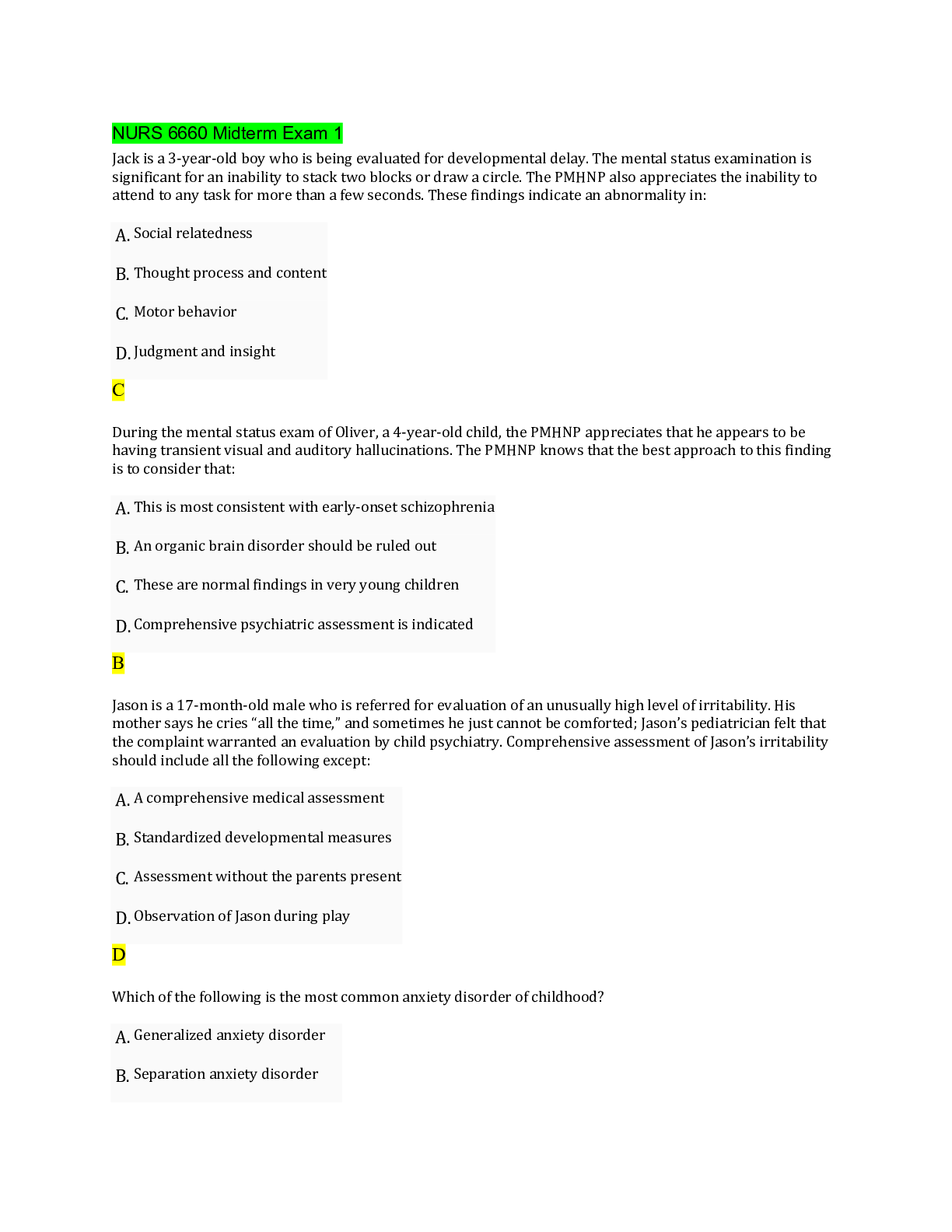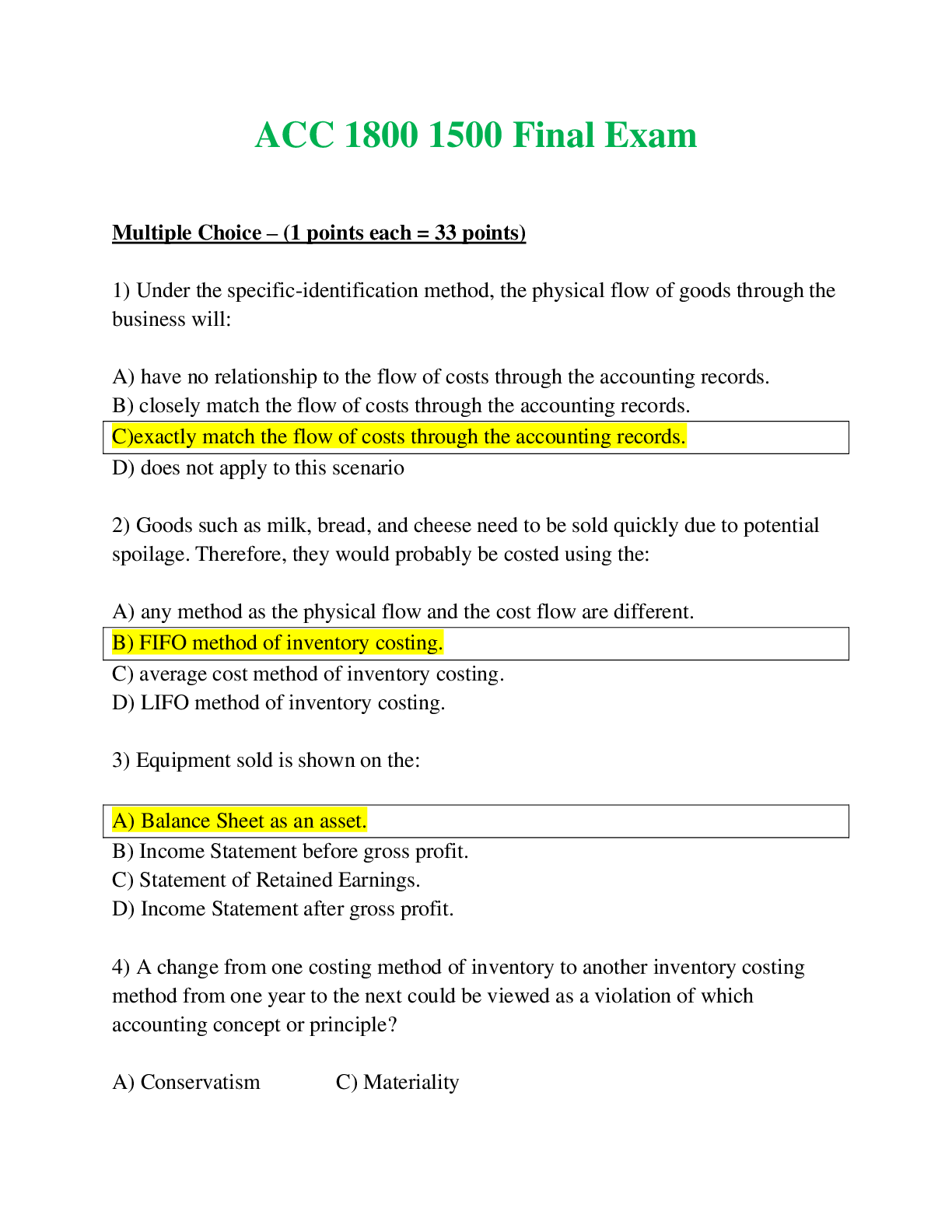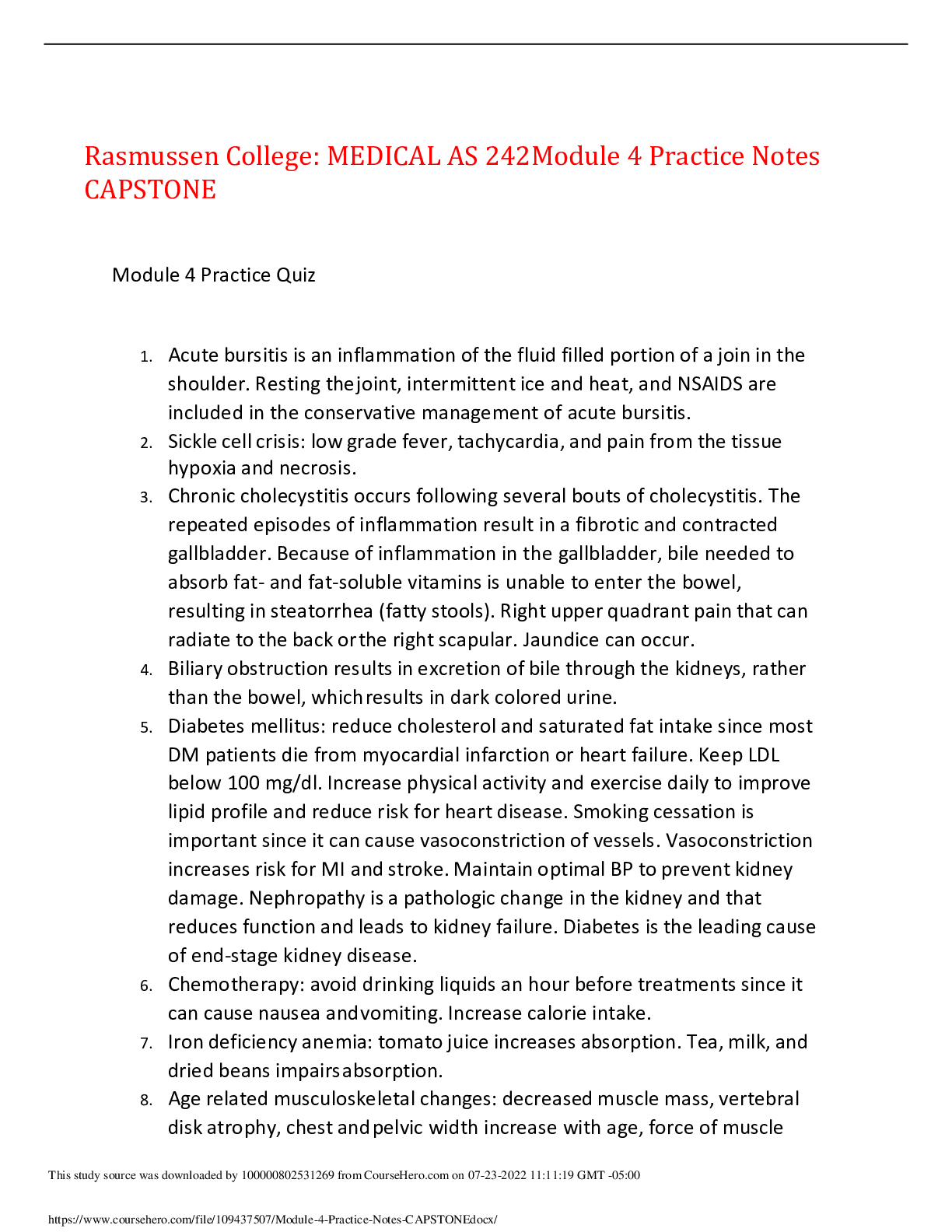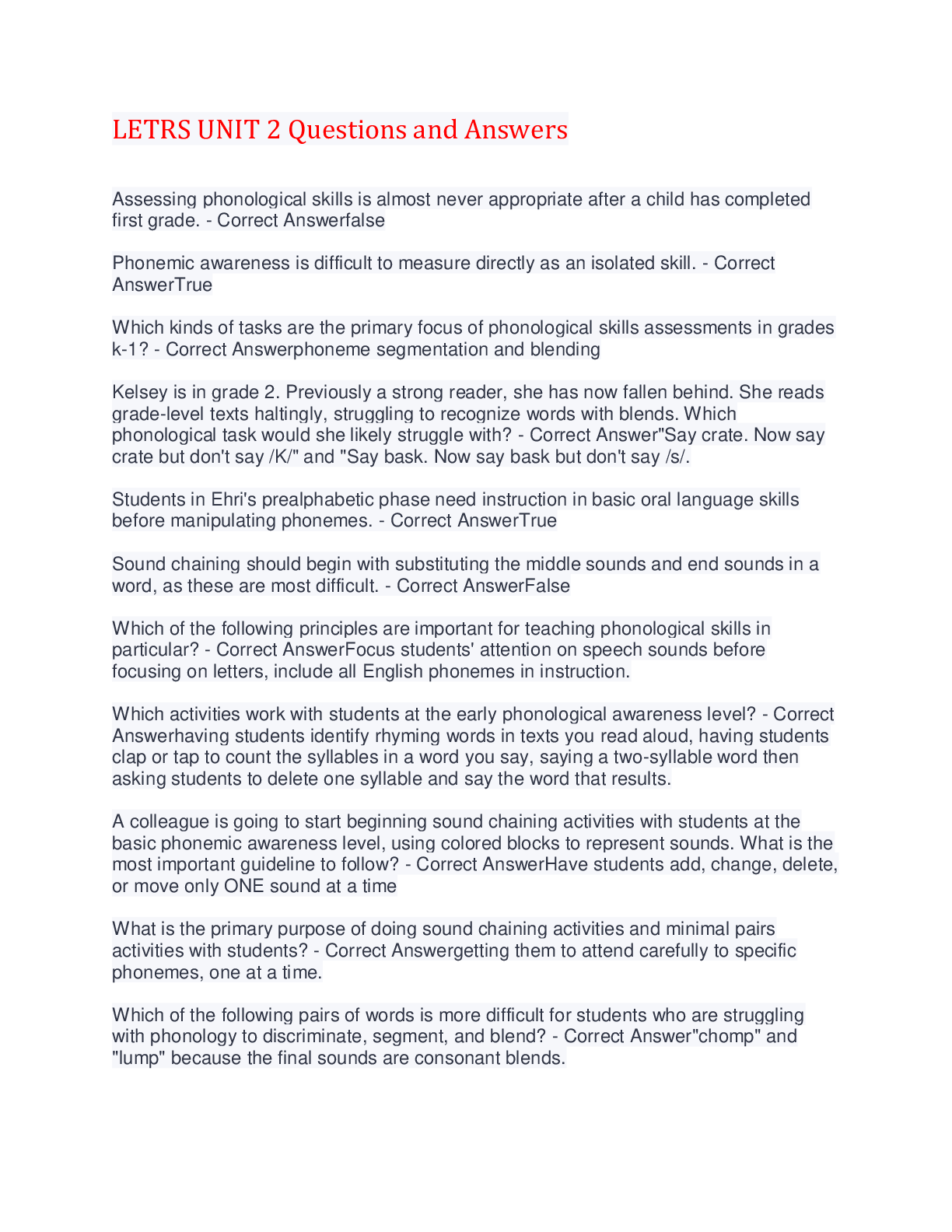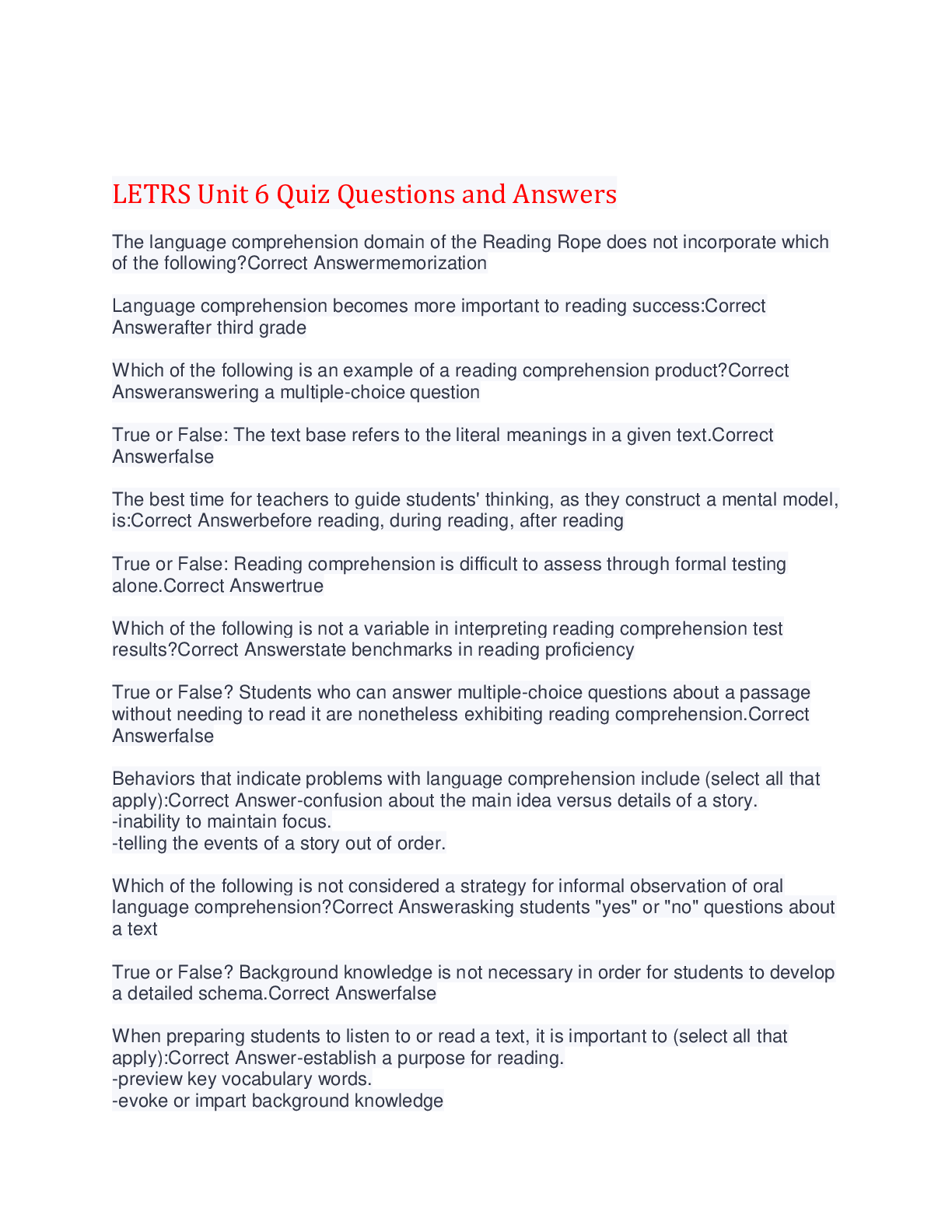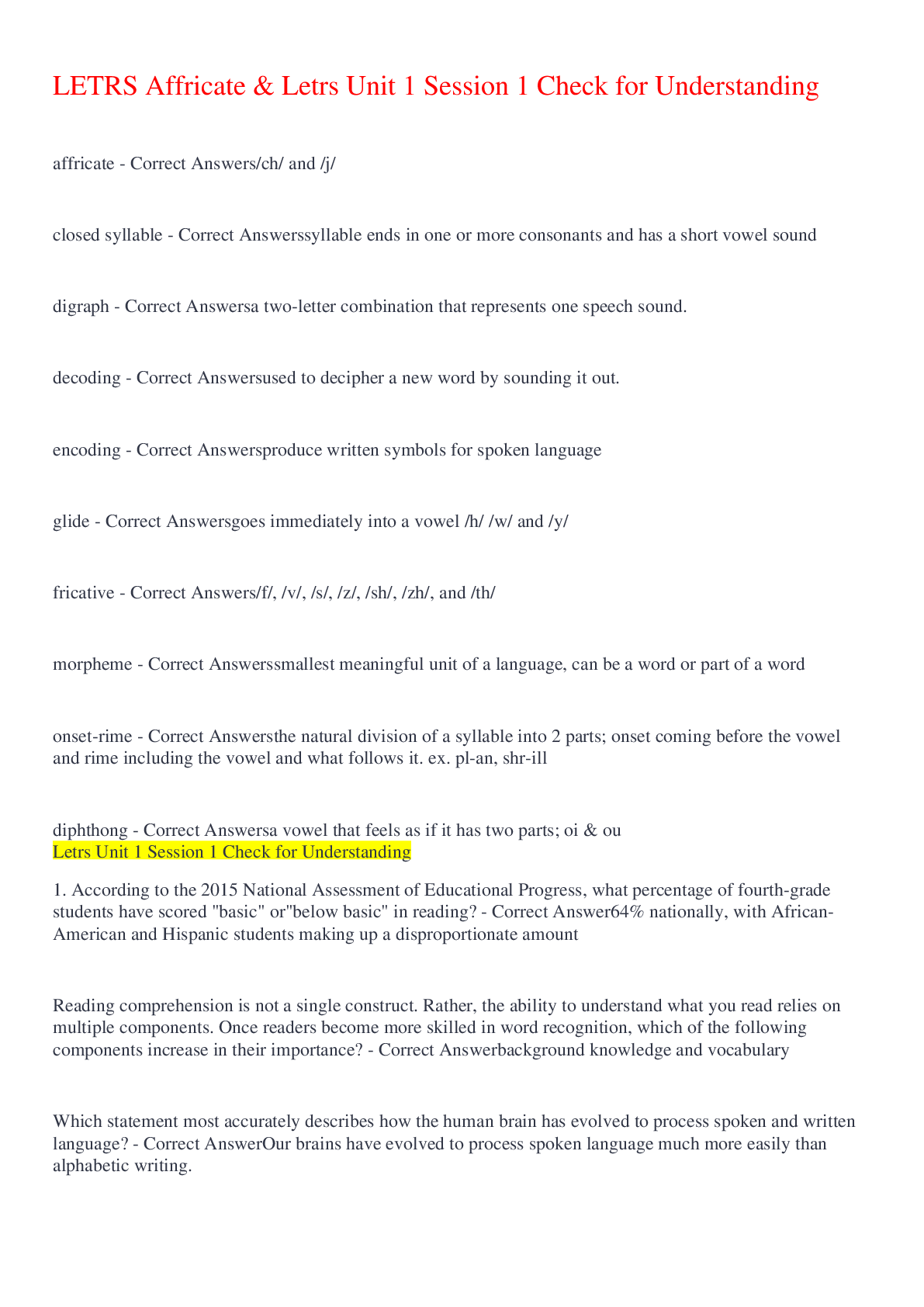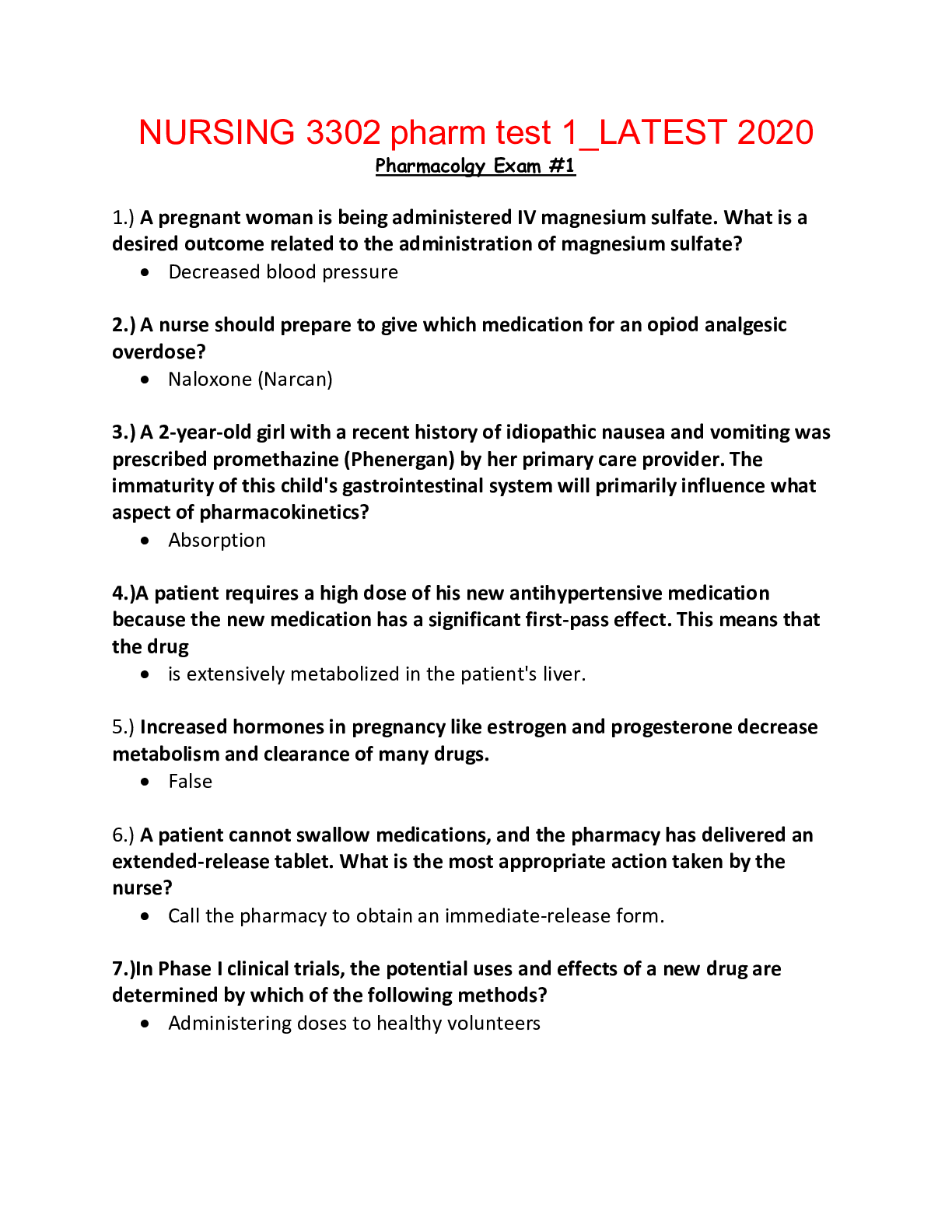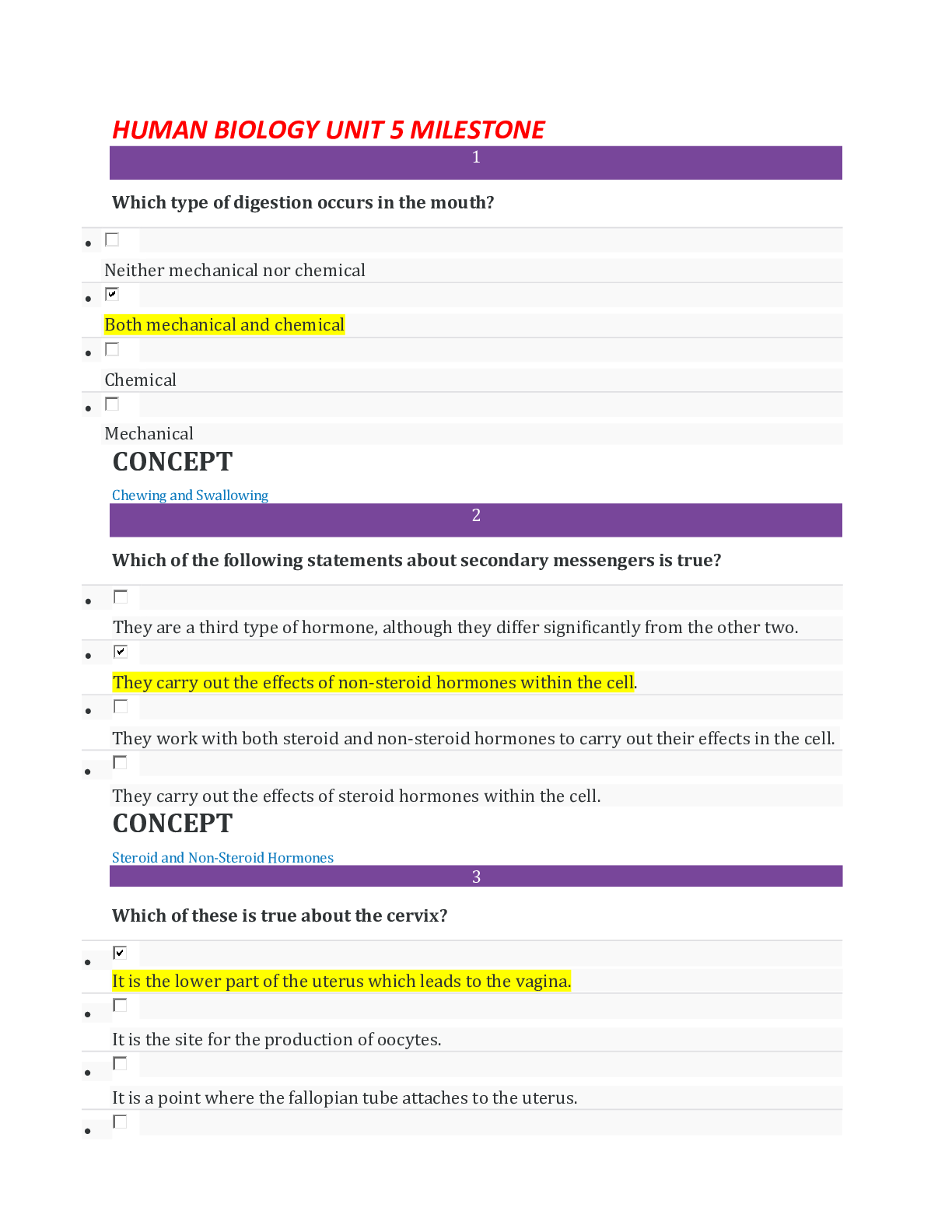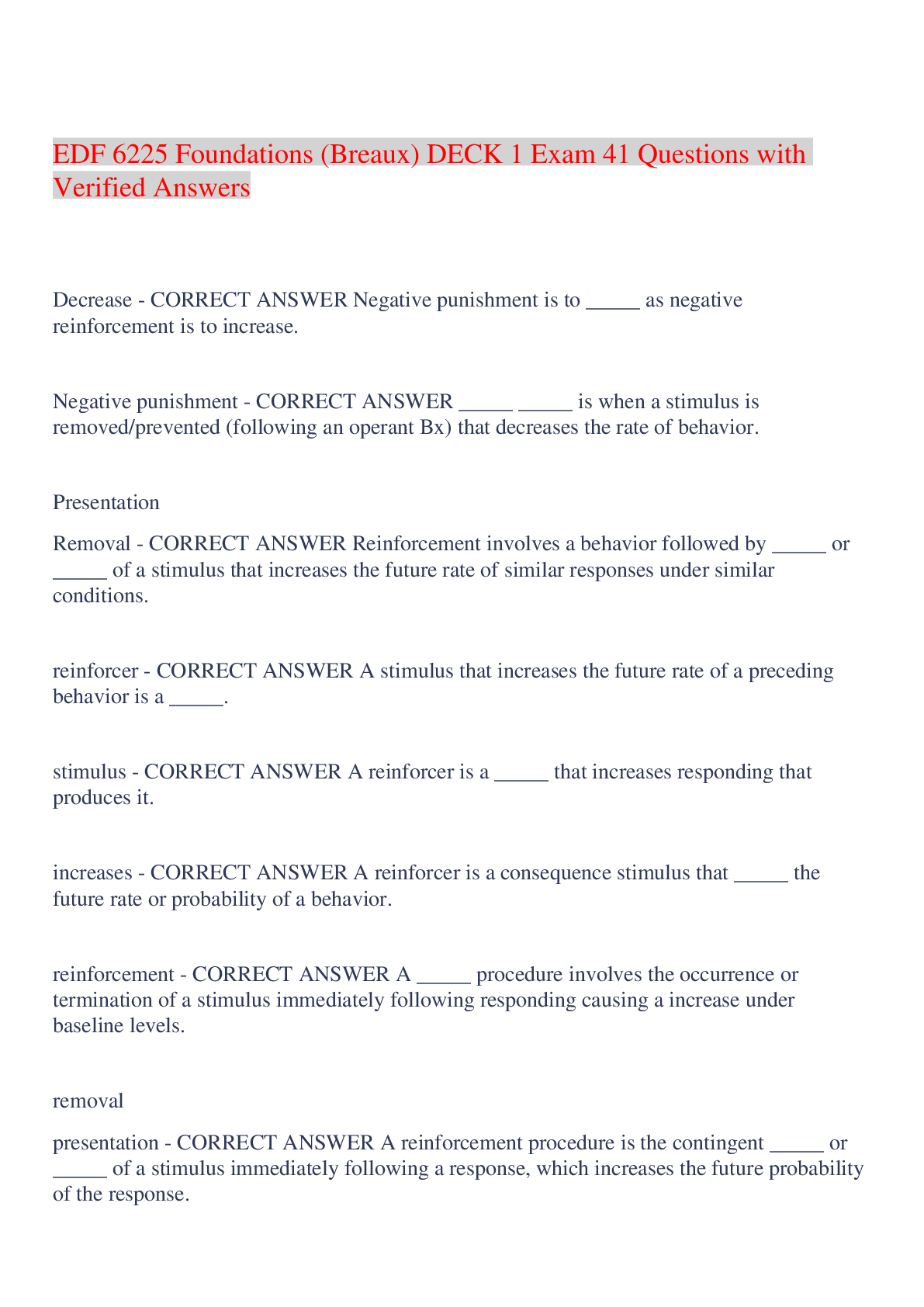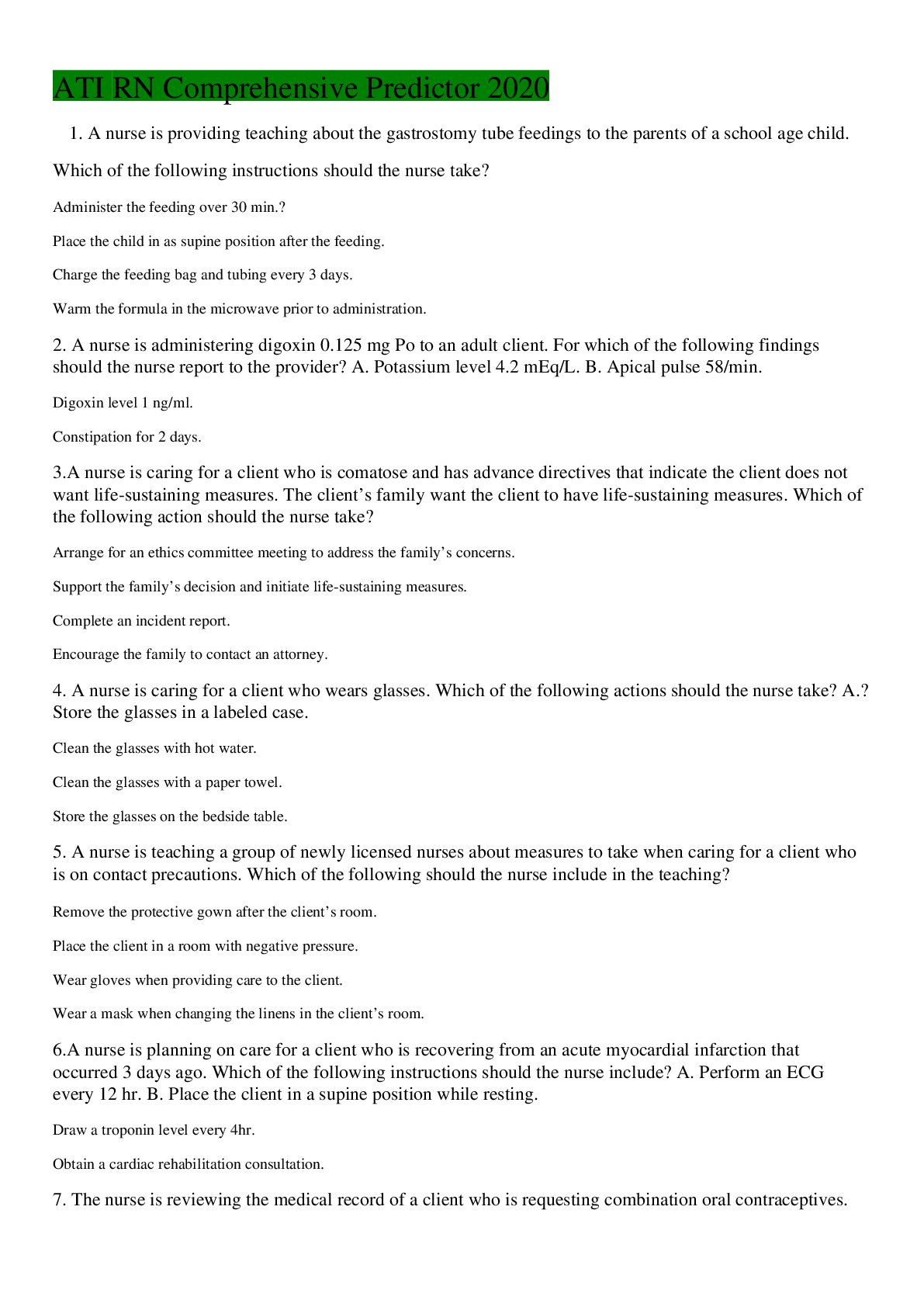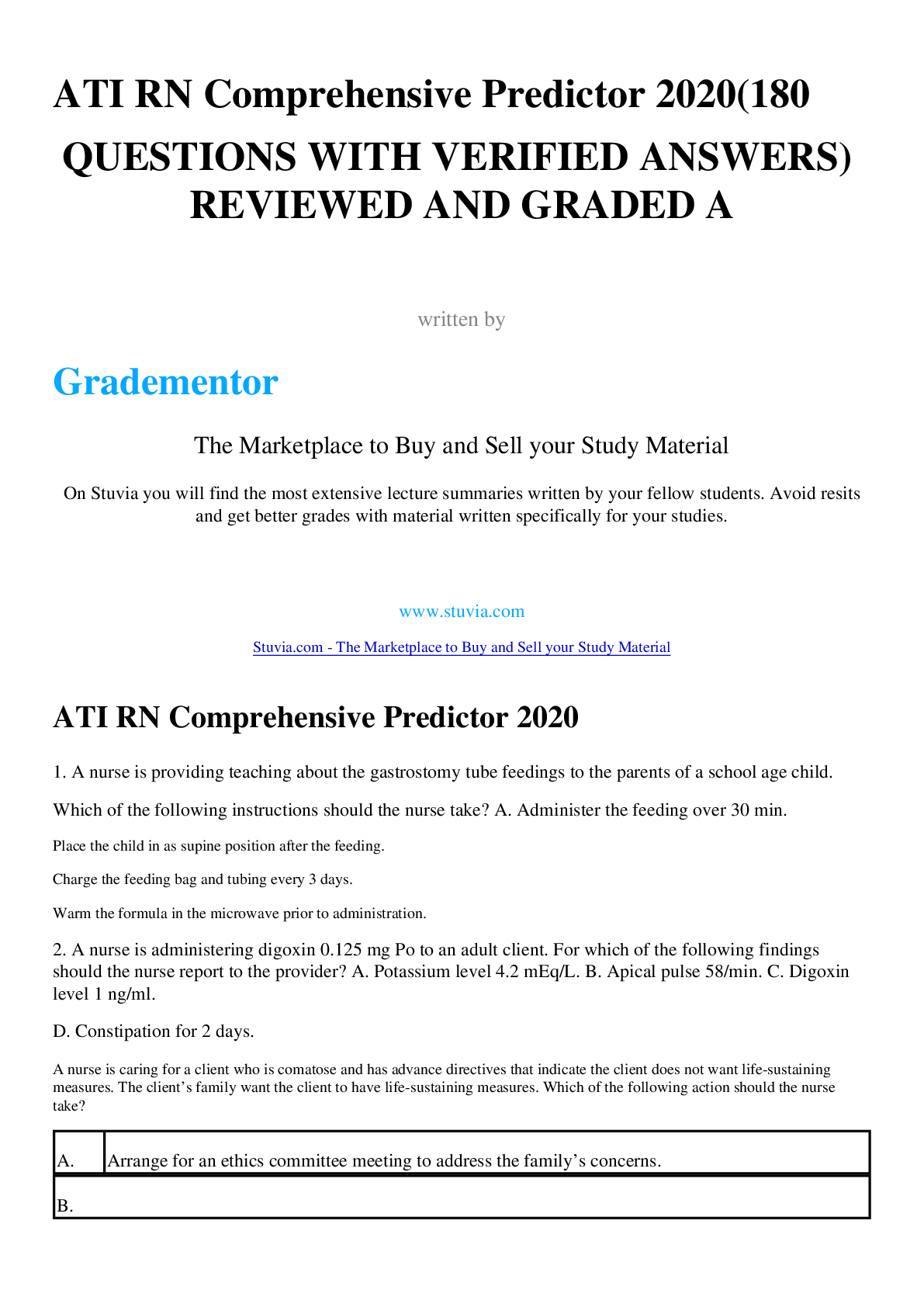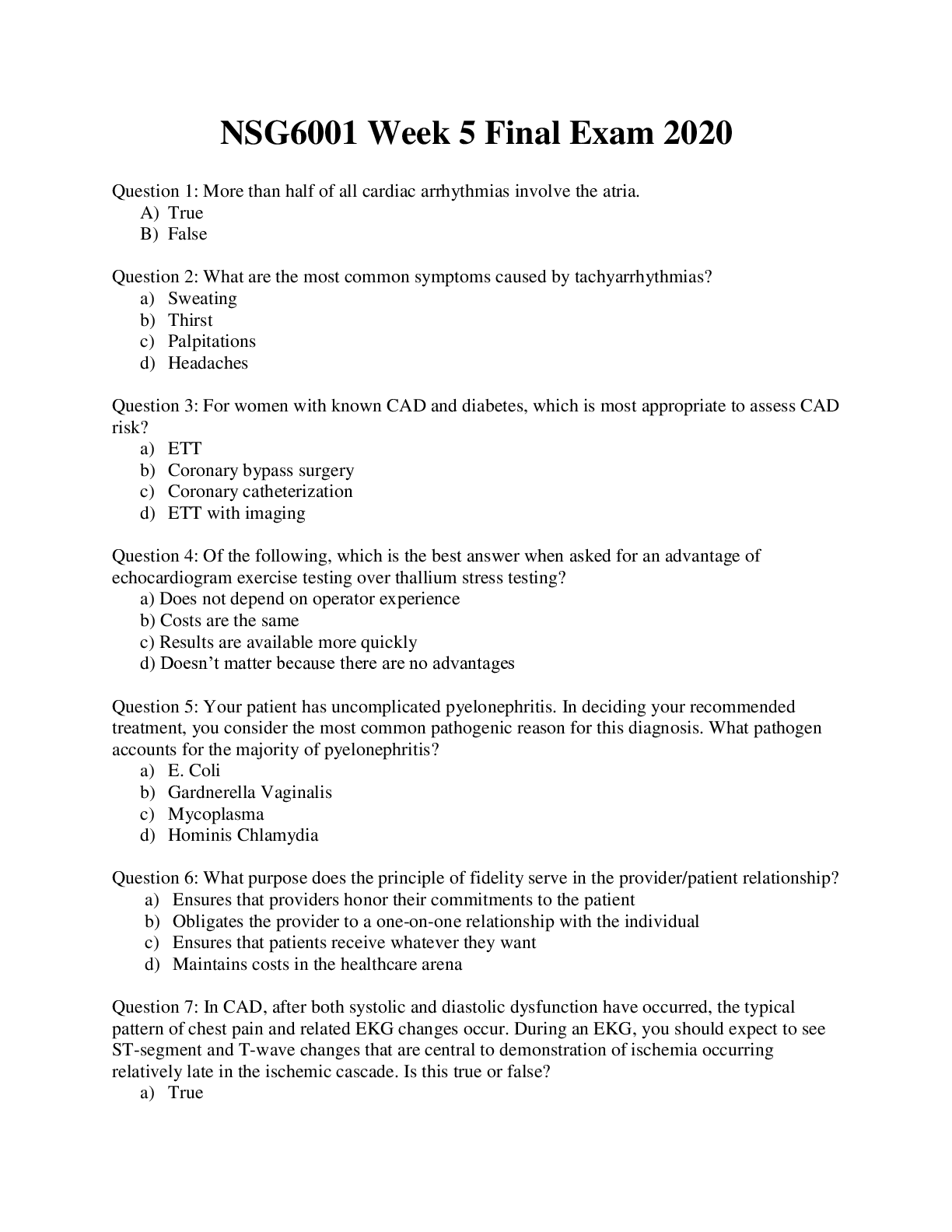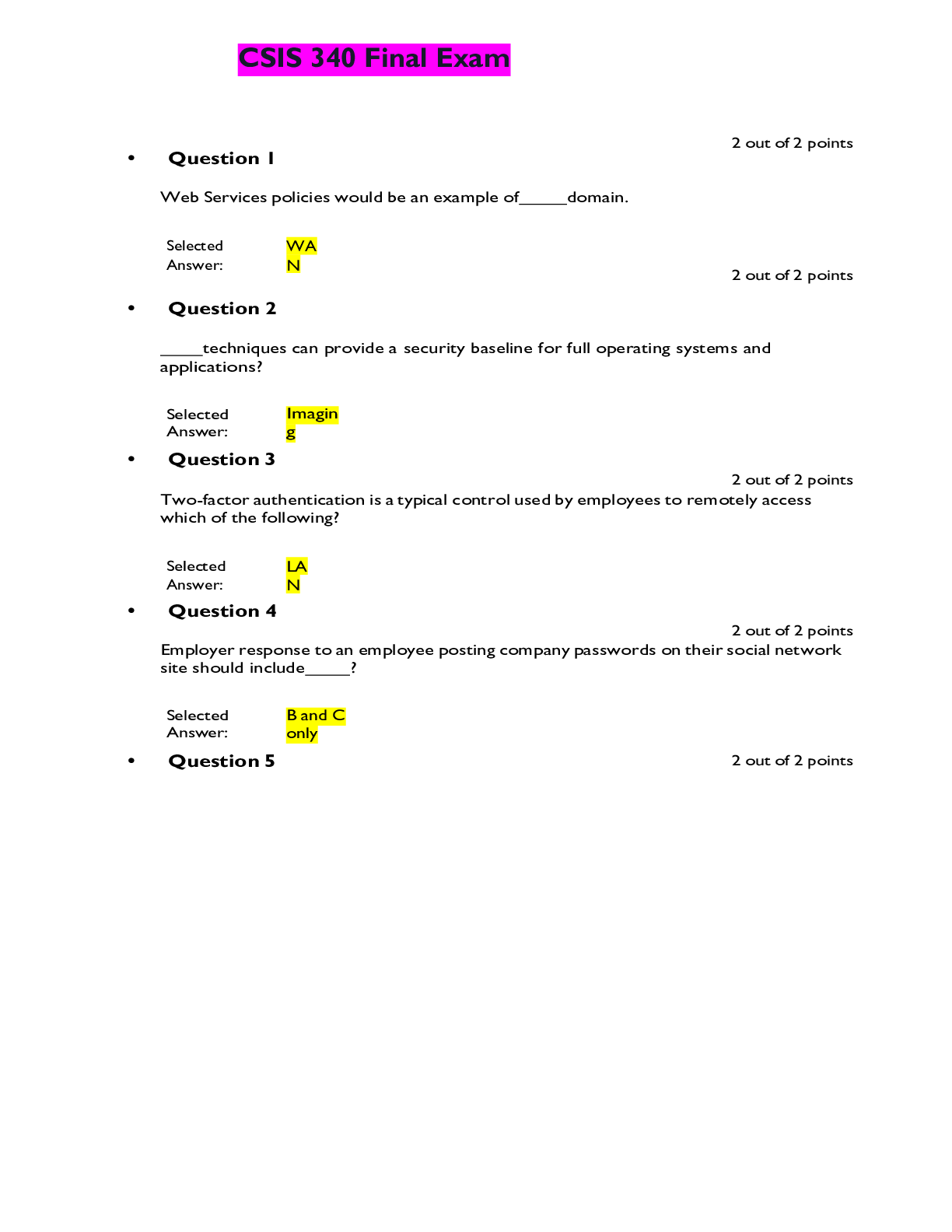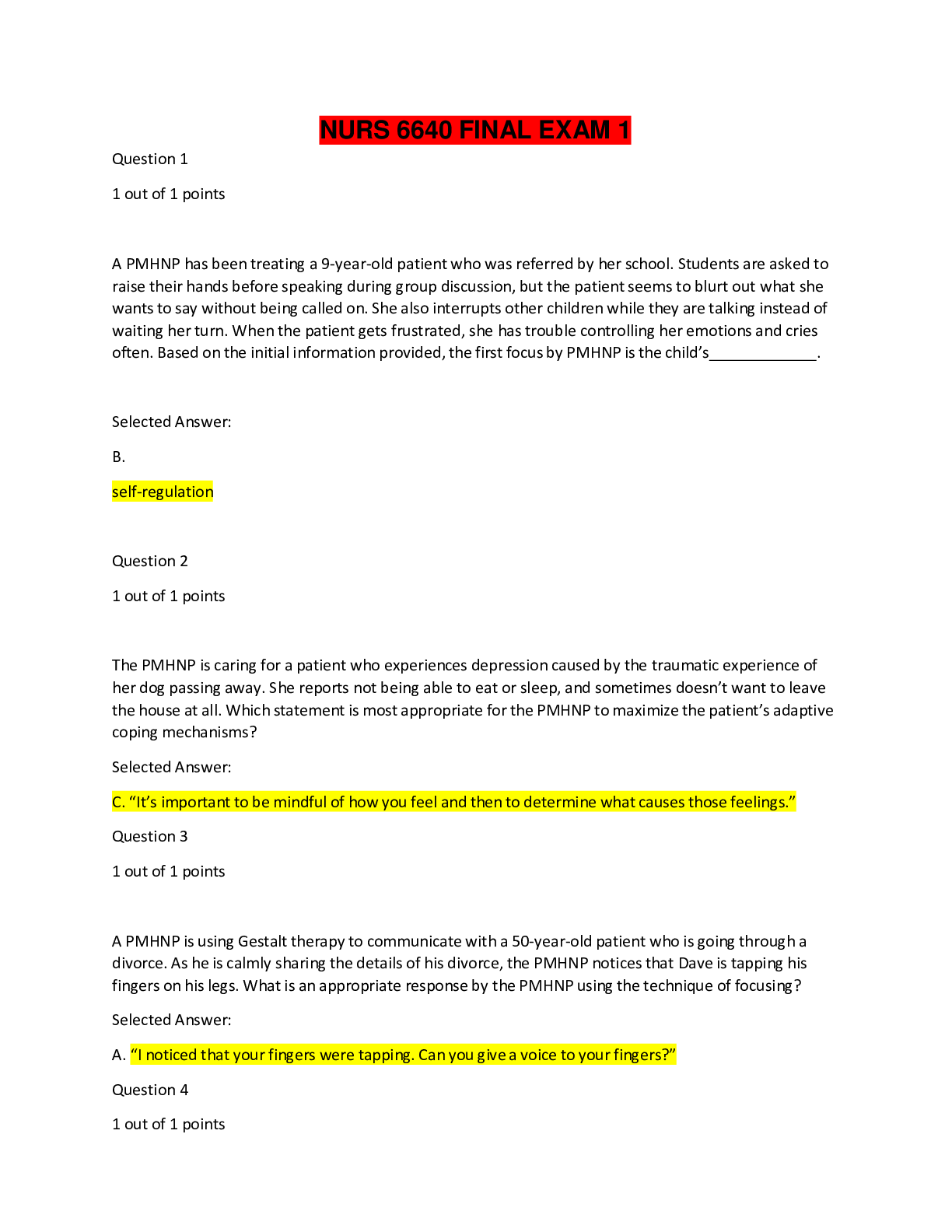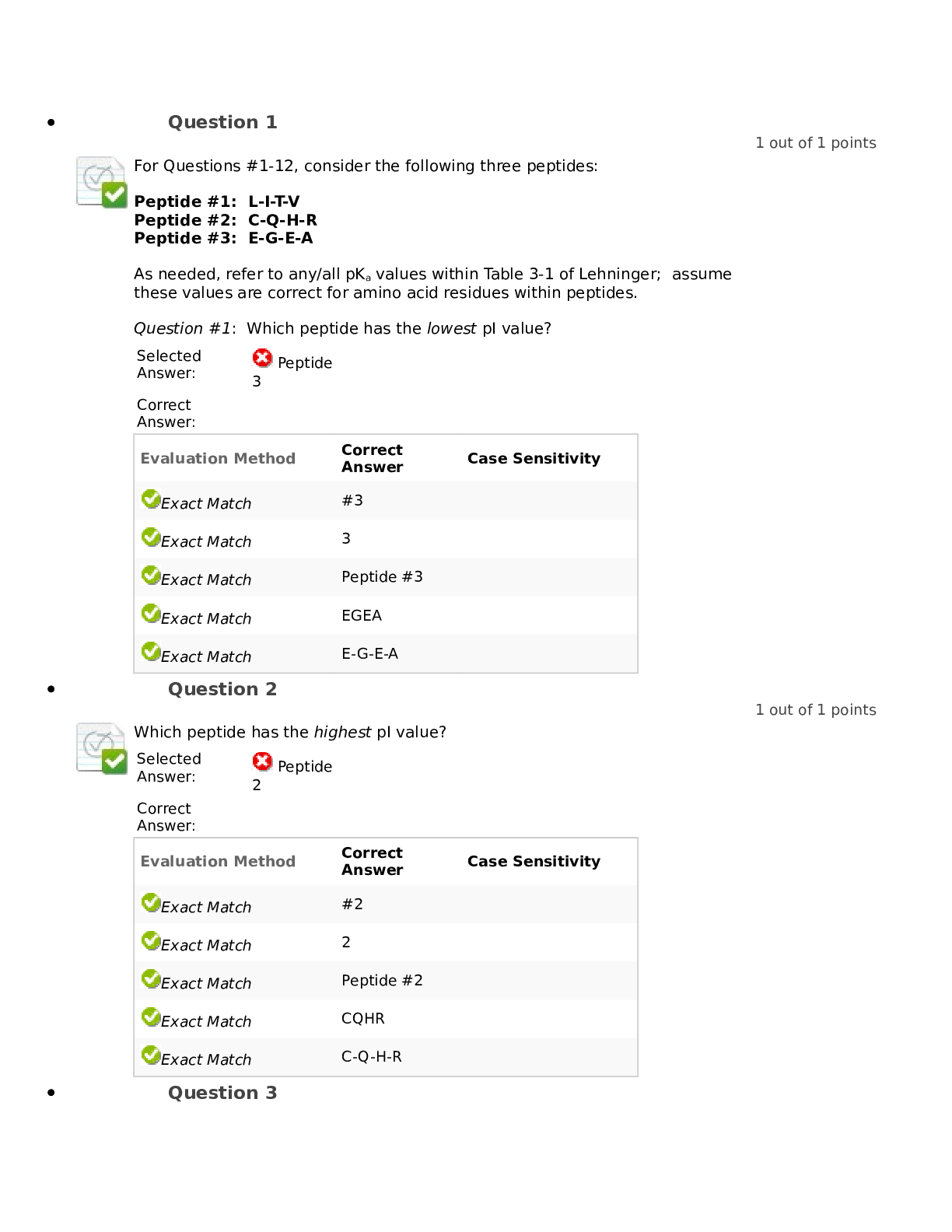*NURSING > EXAM > Kaplan Nursing Research Test 227 Questions with Verified Answers,100% CORRECT (All)
Kaplan Nursing Research Test 227 Questions with Verified Answers,100% CORRECT
Document Content and Description Below
Kaplan Nursing Research Test 227 Questions with Verified Answers Abstract - CORRECT ANSWER A summary or condensed version of the research report (p 15). Electronic databases - CORRECT ANSWER Cat... egorized lists of articles from a wide range of journals, organized by topic, author, and journal source available on CDs or online.(p 14) EBN - CORRECT ANSWER The process that nurses use to make clinical decisions and to answer clinical questions about delivery of care to patients.(p 3) Key Words - CORRECT ANSWER terms that describe the topic or nature of the information sought when searching a database or the internet (pg 15). Knowledge - CORRECT ANSWER Information that furthers our understanding of a phenomenon or question.( pg 11) Outcomes research - CORRECT ANSWER a type of research that evaluates the impact of health care on the health outcomes of patients and populations, including evaluation of economic impacts linked to health outcomes, such as cost effectiveness and cost utility.( pg 5) Printed indexes - CORRECT ANSWER Printed indexes are written lists of professional articles that are organized and categorized by topic and author, and they cover articles written from 1956 to today. They usually can only be found in formal academic libraries and are being used more infrequently since the development of computerized electronic databases.(p 12). Research process - CORRECT ANSWER It is a set of systematic processes that formalize the development of evidence(.p 10). Research utilization - CORRECT ANSWER research utilization means the use of research in practice. p. 3. Systematic review - CORRECT ANSWER it the product of a process that includes asking clinical questions, doing a structured and organized search for theory based information and research related to the question, reviewing and synthesizing the results from that search, and reaching conclusions about the implications for practice.p17, 36. Conclusions - CORRECT ANSWER The end of a research report that identifies the final decisions or determinations regarding the research problem. p 25 Data - CORRECT ANSWER The information collected in a study that is specifically related to the research problem p 27 Descriptive results - CORRECT ANSWER includes statistical procedures that we use to describe the population we are studying. The data could be collected from either a sample or a population, but the results help us organize and describe data. Descriptive statistics can only be used to describe the group that is being studying. That is, the results cannot be generalized to any larger group. Data analysis - CORRECT ANSWER Data are the information collected in a study. Organizing and compiling data are called data analysis. Data analysis pulls elements or information together to present a clear picture of the information collected, but it does not interpret or describe the implications for practice of that picture of the information. Hypothesis - CORRECT ANSWER ideas are stated in the form of a hypothesis—a prediction regarding the relationships or effects of selected factors on other factors. Not every study will have a hypothesis. For a study to include a hypothesis, there must be some knowledge about a problem of interest so that we can propose or predict that certain relationships or effects will occur. If you remember from earlier in the chapter, qualitative research does not try to predict outcomes, and therefore, a hypothesis is seldom appropriate. Limitations - CORRECT ANSWER are the aspects of how the study was conducted that create uncertainty concerning the conclusion that can be derived from the study as well as the decisions that can be based on it. These limitations often address the information presented in the beginning sections of the report, such as the study's methods and sample. Just as the cautious language used in the conclusions section can be frustrating when you are looking for practical answers to clinical questions, the limitations described may make you wonder whether you can use conclusions as evidence on which to practice. That is why the limitations are included in the conclusions: to remind the reader that there are constraints or limits to the knowledge being reported. Limitations do not mean that the results of a study are flawed or meaningless. They do, however, indicate the boundaries of or constraints to the knowledge generated by the research. One might view the limitations as the fence that surrounds and "limits" the new knowledge in the report. Literature review - CORRECT ANSWER a synthesis of the literature that describes what is known or has been studied regarding the particular research question or purpose. Measures - CORRECT ANSWER are the specific method(s) used to assign a number or numbers to an aspect or factor being studied. Meta-analysis - CORRECT ANSWER a quantitative approach to knowledge development that applies statistics to numeric results from different studies that addressed the same research problem to look for combined results that would not happen by chance alone. metasynthesis - CORRECT ANSWER a report of a study of a group of single research studies using qualitative methods. Methods - CORRECT ANSWER the research study, including who was included in the study, how information was collected, and what interventions, if any, were tested. Multivariate - CORRECT ANSWER more than two variables; multivariate studies examine three or more factors and the relationships among the different factors. Problem - CORRECT ANSWER section of a research report that describes the gap in knowledge that will be addressed by the research study or a statement of the general gap in knowledge that will be addressed in a study. Procedures - CORRECT ANSWER specific actions taken by researchers to gather information about the problem or phenomenon being studied. Process improvement - CORRECT ANSWER a management system in which all participants involved strive to improve customer outcomes. Chapter 2, p. 39 Process improvement methods seek to improve the process in which decisions/changes in care delivery are carried out. For example, a traditional research study may seek to answer whether customer satisfaction is improved when a professional translator is assigned to a patient versus the use of a family member for a patient who is Chinese, whereas a process improvement method seeks to improve an approach that increases customer satisfaction for all patients within an organization. P value - CORRECT ANSWER a numerical statement of the percentage of the time the results reported would have happened by chance alone. For example, a p value of .05 means that in only 5 out of 100 times would one expect to get the results by chance alone. Chapter 2, p. 29. Qualitative methods - CORRECT ANSWER approaches to research that focus on understanding the complexity of humans within the context of their lives and tend to focus on building a whole or complete picture of a phenomenon of interest; qualitative methods involve the collection of information as it is expressed naturally by people within the normal context of their lives. Chapter 2, p. 30. Quality improvement - CORRECT ANSWER a process of evaluation of health care services to see whether they meet specified standards or outcomes of care.Chapter 2, p. 38. Quality improvement often is based on research, and the process and product resemble the research process. The questions in quality improvement are whether a certain set of actions is occurring and how desirable outcomes can be facilitated. This is a form of a descriptive research question. Quality improvement study - CORRECT ANSWER a study that evaluates whether or not certain expected clinical care was completed. Chapter 2, p. 38. quality improvement studies also often examine relationships among factors that may affect the outcome or actions of interest. Just as we want to know what factors may influence a clinical problem of interest, we want to know what factors influence the consistency of achievement of standards or outcomes. Quantitative methods - CORRECT ANSWER approaches to research that focus on understanding and breaking down the different parts of a picture to see how they do or do not connect; quantitative methods involve the collection of information that is very specific and limited to the particular pieces of information being studied.Chapter 2, p. 30.qualitative research assembles the pieces of a puzzle into a whole picture, whereas quantitative research selects pieces of a completed puzzle and breaks them down into their component parts. Data reduction - CORRECT ANSWER organizing large amounts of data, usually in the form of words, so that it can be broken down (reduced) and labeled (coded) to identify which category it belongs Data saturation - CORRECT ANSWER the point at which all new information collected is redundant of info already collected Demographic - CORRECT ANSWER descriptive info about the characteristics of the people studied Dependent variable - CORRECT ANSWER the outcome variable of interest; it is the variable that depends on other variables in the study. Distribution - CORRECT ANSWER the spread among the values for a variable. Frequency distribution - CORRECT ANSWER a presentation of data that indicates the spread of how often values for a variable occurred. Independent variables - CORRECT ANSWER those factors in a study that are used to explain or predict the outcome of interest; independent variables also are sometimes called predictor variables because they are used to predict the dependent variable. Inferential statistics - CORRECT ANSWER statistics that are most commonly used in quantitative studies allowing the researcher to draw conclusions based on evidence obtained from a sample population. Inference - CORRECT ANSWER the reasoning that goes into the process of drawing a conclusion based on evidence. Mean - CORRECT ANSWER the arithmetic average for a set of values. Measure of central tendency - CORRECT ANSWER a measure that shows the common or typical values within a set of values; central tendency measures reflect the "center" of a distribution, or the center of the spread; the mean, the mode, and the median are the three most commonly used. Median - CORRECT ANSWER a measure of central tendency that is the value in a set of numbers that falls in the exact middle of the distribution when the numbers are in order. Probability - CORRECT ANSWER the percentage of the time that the results found would have happened by chance alone. Regression - CORRECT ANSWER a statistical procedure that measures how much one or more independent variables explain the variation in a dependent variable. Research hypothesis - CORRECT ANSWER a prediction of the relationships or differences that will be found for selected variables in a study. T test - CORRECT ANSWER t test was used to test for significant differences. A t test computes a statistic that reflects the differences in the means of a variable for two different groups or at two different times for one group. Bias - CORRECT ANSWER some unintended factor that confuses or changes the results of the study in a manner that can lead to incorrect conclusions: bias distorts or confounds the findings in a study, making it difficult to impossible to interpret the results. Cluster sampling - CORRECT ANSWER a process of sampling in stages, starting with a larger element that relates to the population and moving downward into smaller and smaller elements that identify the population. Convenience sample - CORRECT ANSWER a sample that includes members of the population that can be readily found and recruited. Criteria for participation - CORRECT ANSWER factors that determine how individuals are selected for a study; they describe the common characteristics that define the target population for a study. Generalizability - CORRECT ANSWER the ability to say that the findings from a particular sample can be applied to a more general population. Matched sample - CORRECT ANSWER the intentful selection of pairs of subjects that share certain important characteristics to prevent those characteristics from confusing what is being explained or understood within the study. Nonprobability sampling - CORRECT ANSWER a sampling approach that does not necessarily ensure that everyone in the population has equal chance of being included in the study. Population - CORRECT ANSWER the entire group of individuals about whom we are interested in gaining knowledge. Response rate - CORRECT ANSWER the proportion of individuals who participate in a study divided by the number who agreed to be in a study but did not participate in it. Sample - CORRECT ANSWER a smaller group, or subset of a group, of interest that is studied in a research. Sampling frame - CORRECT ANSWER The pool of all potential subjects (pool of all individuals who meet the criteria for the study) for a study. this term is associated with convenience sampling Sampling unit - CORRECT ANSWER The element of the population that will be selected and analyzed in the study. The unit depends on the population of interest and can comprise individuals, but it can also be hospitals, families etc. Occasionally, samples consist of more than one sampling unit. Saturation of data - CORRECT ANSWER The point in data collection at which the data become repetitive and no new information or participants is being added. Selectivity - CORRECT ANSWER The tendency of certain population segments to agree to participate in studies.(the bias is not introduced by researcher). for example: more women, more educated people etc. Content Validity - CORRECT ANSWER Quantitative- If the items or questions on a scale are comprehensive and appropriately reflect the concept they are supposed to measure. Credibility - CORRECT ANSWER Qualitative- Refers to the confidence that the researcher and the user of the research can have in the truth of the finding of the study. Criterion Related Validity - CORRECT ANSWER Quantitative- The extent to which he results of one measure match those of another measure that is supposed to reflect the variable under study. Error - CORRECT ANSWER The difference between what is true and the answer we obtained in our data collection. Field notes - CORRECT ANSWER Qualitative- Documentation of a participant's particular tone, expressions, and associated actions, and what is going on in the setting at the same time; they are a record of the researcher's observations about the overall setting and experience of the data collection process while in that setting or field itself; field notes are used to enrich and build a set of data that is thick and dense. Group Interviews - CORRECT ANSWER Qualitative- The collection of data by interviewing more than one participant at a time. Instrument - CORRECT ANSWER A term used in research to refer to a device that specifies and objectifies the process of collecting data. Internal consistency reliability - CORRECT ANSWER to extent to which responses to a scale are similar and related. Inter-rater reliability - CORRECT ANSWER Consistency in measurement that is present when two or more independent data collectors agree in the results of their data collection process. Items - CORRECT ANSWER The question or statements included on a scale used to measure a variable of interest. Likert-type response scale - CORRECT ANSWER A response scale that asks for a rating of an item on a continuum that is anchored at either end by opposites responses. Member Checks - CORRECT ANSWER A process in qualitative research where the data and the findings from their analysis are brought back to the original participants to seek their input as to the accuracy, completeness, and interpretation of the data. Operational definition - CORRECT ANSWER A variable that is defined in specific, concrete terms of measurement. (Height in inchs etc.) Participant observation - CORRECT ANSWER A qualitative measure where the researcher intentionally embeds themselves into the environment from which data will be collected and becomes a participant. (Jane Goodall and the Gorillas) Questionnaire - CORRECT ANSWER A witten measure that is used to collect specific data, usually offering closed or forced choices for answers to the questions. Reliability - CORRECT ANSWER The consistency with which a measure can be counted on to give the same result if the aspect being measured has not changed. Rigor - CORRECT ANSWER A strict process of data collection and analysis as well as a term that reflects the overall quality of that process in qualitative research: rigor is reflected inthe consistency of data analysis and interpretation, the trustworthiness of the data collected, the transferability of the themes and the credibility of the data. Scale - CORRECT ANSWER A set of written questions or statement that in combination are intended to measure a specified variable. (Pain Scales, etc.) Semistructured questions - CORRECT ANSWER questions asked in order to collect data that specifically targets objective factors of interest Structured questions - CORRECT ANSWER questions that establish what data is wanted ahead of the collection and do not allow the respondent flexibility in how to answer. Test-retest reliability - CORRECT ANSWER consistency in the results from a test when individuals fill out a questionnaire or scale at two or more time points that are close enough together that we would not expect the "real" answers to have changed. Chapter 8, p. 162. Theoretical definition - CORRECT ANSWER a conceptual description of a variable Chapter 8, p. 148. Transferability - CORRECT ANSWER the extent to which the findings of a qualitative study are confirmed or seem applicable for a different group or in a different setting from where the data were collected. p 154 Triangulation - CORRECT ANSWER a process of using more than one source of data to include different views, or literally to look at the phenomenon from different angles p 155 Experimenter effects - CORRECT ANSWER This occurs when some characteristics of the researcher or data collector influences the study results. This is a threat to external validity in a quantitative study. External Validity - CORRECT ANSWER The extent to which the results of the study can be applied to other groups or situations. Refers to how accurately the study provides knowledge that can be applied outside fo , or external to, the study. Grounded Theory - CORRECT ANSWER A qualitative method commonly used to study interactions to understand and recognize links between ideas and concepts or in other words, develop a theory. Hawthorne Effect - CORRECT ANSWER A threat to external validity that occurs when subjects is a study change simply because they are being studied, no matter what interventions is applied. The same as reactivity. Historical Research Method - CORRECT ANSWER A qualitative research method used to answer questions about linkages in the past to understand the present or plan the future. History - CORRECT ANSWER A threat to internal validity that occurs because of some factor outside those examined in the a study, affecting the study outcome or dependent variable. Model - CORRECT ANSWER symbolic framework for a theory or part of theory p.190 Mortality - CORRECT ANSWER A threat to internal validity that refers to the loss of subjects from a study due to a consistent factor related to the dependant variable p.180 Multifactorial - CORRECT ANSWER A study that has a number of independent variables that are manipulated p. 191 Novelty effects - CORRECT ANSWER threat to external validity that occurs when the knowledge that what is being done is new and under study somehow affects the outcome, favorably or unfavorably p. 181 Phenomenology - CORRECT ANSWER a qualitative method used to increase understanding of experiences as perceived by those living the experience p.184 Pretest-posttest - CORRECT ANSWER A research design that includes an observation both before and after the intervention. P. 191 Who is the first nurse researcher? - CORRECT ANSWER Florence Nightingale wrote "notes on nursing" in 1860 p.4 What was nurse research like in the 1940s and 50s? - CORRECT ANSWER It focused on characteristics of nurses and nurse education. p.4 What years did the shift to EBP get started for nursing? - CORRECT ANSWER 1960s to 1970 . 1960 Theoretical foundations. 1970 Clinical practice p.4 In what year did the NIH start the National center of Nursing Research - CORRECT ANSWER 1986. Name changed to National Institute of Nursing Research in 1993. A big deal because it made nursing a major player in health care research. (Chapter 1 slides) What are the 5 questions you should be able to answer after reading a research report? - CORRECT ANSWER 1. What is the answer to my practice question—what did the study conclude? 2.Why did the author(s) reach these conclusions—what did they actually find? 3. To what types of patients do these research conclusions apply—who was in the study? 4. How were these patients studied—why was the study done that way? 5. Why ask that question—what do we already know? (Chapter 1 slides) What are 3 major sources for identifying reports of research - CORRECT ANSWER 1. Printed indexes 2. The internet 3. Electronic Databases. (Chapter 1 slides) What is nursing research? - CORRECT ANSWER The systematic gathering of information to gain expand or validate knowledge about health and responses to health problems. (Chapter 1 slides) Name two things that don't qualify as a research report. - CORRECT ANSWER 1. A description of a procedure or intervention that mentions a research study. 2. A literature review. (Chapter 1 slides) describe 3 types of research reports - CORRECT ANSWER 1. A published report that identifies a problem or a question. 2. A published report that describes a planned and organized set of actions to gather information about the problem or question. 3. A published report that describes new information to address a gap in knowledge. What are the top levels of research based evidence? - CORRECT ANSWER 1. Reports of multiple research studies (meta studies) 2. Individual randomized Controlled trials (RCT) 3. Non experimental research (descriptive studies) (Chapter 1 slides) What are some none research based evidence people use? - CORRECT ANSWER 1. Clinical reports 2. Nurses experiences 3. Textbooks 4. Opinions, beliefs and untested experiences. (Chapter 1 slides) What are the 4 main parts of a research REPORTS? - CORRECT ANSWER 1. Problem/Introduction 2. Methods 3. Results 4. Conclusion/Discussion (Chapter 2 slides) What does the conclusions section of a research report do? - CORRECT ANSWER Complete a report and identify the outcome of the study. State the investigator's "answer" for the research problem. In nursing, implications for practice. True or False: A limitation of a study may include a disproportionate number of males to females within the study's sample. - CORRECT ANSWER True Rationale: Inadequate sampling may be considered a limitation of the study if the true population is not included. For example, an unequal number of female to male participants in any research study may be a limitation if both genders should be represented equally. What's the results section of a research report for? - CORRECT ANSWER Results contain a condensed version of what the investigators believe to be the most important findings. Results reflect data analysis: the process of organizing and testing data to create a clearer picture of the information collected. What belongs in the results section of a research report? - CORRECT ANSWER Themes: abstractions that summarize and synthesize discrete ideas. Descriptive results: summarize information without comparing it to other information Example: average age of subjects in study Multivariate results: report of findings and any relationships for three or more factors Statistical test results Significance p values Tell whether the following statement is True or False: A .50 p value means that only 5 out of 100 times would a reported result be due to chance alone. - CORRECT ANSWER False Rationale: A p value does determine the likelihood the result is due by chance alone. However, the p value should be .05 signifying that 5 times out of 100 the result is due to chance. What's a p value of less then .05 mean? - CORRECT ANSWER When the p value is less than .05 (less than 5%), we agree that the findings likely are "real"; that is, they occurred because of some factor we are studying, rather than by simple chance alone. What's the methods section of the research report suppose to do? - CORRECT ANSWER Describe how information was collected, what was tested, how patients were included Describe the systematic procedures used to generate or confirm knowledge Two major categories of methods Qualitative Quantitative What belongs in the methods section of a research report? - CORRECT ANSWER Sampling Data collection procedures Data analysis methods What type of data collection method is most appropriate for quantitative research? Checklists,Interviews,Videos or Logs? - CORRECT ANSWER Checklists Rationale: A checklist is most appropriate to be utilized for data collection in quantitative studies. A specific number is assigned to any answer choice. Statistics can then be easily computed through data analysis. What belongs in the problems section of a research report? - CORRECT ANSWER Describes the gap in knowledge that is addressed by the research study Addresses: Why the research is needed Why the study methods were used What the researcher may be predicting Includes literature review What are the 5 main parts of the research PROCESS? - CORRECT ANSWER 1. Define problem or gap in knowledge 2. Plan approach to acquire answer to the problem or gap in knowledge 3. Implement study 4. Analyze and interpret findings 5.Disseminate results How does the research process differ for qualitative and quantitative studies? - CORRECT ANSWER Types of problems addressed Study methods Process of implementation and types of data collected Approach to analysis and interpretation Results - CORRECT ANSWER a summary of the actual findings or information collected in the research study. Sample - CORRECT ANSWER a subset of the total group of interest in the research study; individuals in the sample are actually studied to learn about the total group. Significance - CORRECT ANSWER a statistical term indicating the low likelihood that any differences or relationships found in the study happened by chance alone. Statistics - CORRECT ANSWER the language that describes data analysis of information in numbers. Systematic - CORRECT ANSWER review: the product of a process that includes asking clinical questions, doing a structured and organized search for theory based information and research related to the question, reviewing and synthesizing the results from that search, and reaching conclusions about the implications for practice Themes - CORRECT ANSWER results in qualitative research that are ideas or concepts that are implicit in the data and are recurrent throughout the data; abstractions that reflect phrases, words, or ideas that appear repeatedly as a researcher analyzes what people have said about a particular experience, feeling, or situation. A theme summarizes and synthesizes discrete ideas or phrases to create a picture out of the words that were collected in the research study Speculation - CORRECT ANSWER a process of reflecting on the results of a study and putting forward some explanation for them. Study design - CORRECT ANSWER the overall plan or organization of a study Bivariate analysis - CORRECT ANSWER Statistical analysis involving only two variables. Categorization scheme - CORRECT ANSWER an orderly combination of carefully defined groups where there is no overlap among categories. Coding - CORRECT ANSWER reducing a large amount of data to numbers or conceptual groups in qualitative research; giving individuals datum numerical values in quantitative research. Content analysis - CORRECT ANSWER the process of understanding, interpreting, and conceptualizing the meanings imbedded in qualitative data. Mode - CORRECT ANSWER The value for a variable that occurs most frequently. Normal Curve - CORRECT ANSWER A type of distribution for a variable that is shaped like a bell and is symmetrical. Predictor variables or independent variables - CORRECT ANSWER The factors in a study that are expected to affect the dependant variable in a specific manner. Skew - CORRECT ANSWER A distribution where the middle of the distribution is not the exact center; the middle or peak of the distribution is to the left or right of center. Standard Deviation - CORRECT ANSWER A: statistic that is the square root of the variance; commuted as the average differences in values for the variable. Theme - CORRECT ANSWER results in qualitative research that are ideas or concepts that are implicit in the date and are recurrent throughout the data. Univariate Analysis - CORRECT ANSWER statistical analysis about only one variable Variable - CORRECT ANSWER Some aspect of interest that differs among different people or situations; something that varies; it is not the same for everyone in every situation. Variance - CORRECT ANSWER the diversity in data for a single variable; a statistic that is the squared deviations of values from the mean value and reflects the distribution of values for the variable. Analysis of Variance - CORRECT ANSWER (ANOVA) a statistical test for differences in the means in three or more groups Beta Value - CORRECT ANSWER a statistic derived from regression analysis that tells us the relative contribution or connection of each factor to the dependent variable. Confidence intervals - CORRECT ANSWER the range of values for a variable, which would be found in 95 out of 100 samples; confidence intervals set boundaries for a variable or test statistic. Coercion - CORRECT ANSWER involves some element of controlling or forcing someone to do something. In the case of research, coercion would occur if a patient felt forced to participate in order to receive a particular test, service, or treatment. Even if not forced to agree to participate in a study, a potential subject still experiences coercion if he or she feels that the best possible care will not be given if the choice is made not to participate. Confidentiality - CORRECT ANSWER assurance that neither the identities of participants in the research will be revealed to anyone else, nor will the information that participants provide individually be publicly divulged. Exempt - CORRECT ANSWER a category of research that is free from some of the constraints that are normally imposed upon research involving human subjects (United States Department of Health & Human Services, 2007) Five human rights in research - CORRECT ANSWER rights that have been identified by the American Nurses Association guidelines for nurses working with patient information that may require interpretation; they include the right to self determination, the right to privacy and dignity, the right to anonymity and confidentiality, the right to fair treatment, and the right to protection from discomfort and harm (ANA, 1985). Informed consent - CORRECT ANSWER the legal principle that an individual of his or her authorized representative is given all the relevant information needed to make a decision about participation in a research study and is given a reasonable amount of time to consider that decision. Institutional review board (IRB) - CORRECT ANSWER a group of members selected for the explicit purpose of reviewing any proposed research study to be implemented within an institution or by employees of an institution to ensure that the research project includes to protect the rights of its subjects; the IRB is also charged to decide whether or not the research is basically sound in order to ensure potential participants' rights to protection from discomfort or harm. Practice - CORRECT ANSWER actions that are planned exclusively for the enhancement of health and the improvement of the well-being of an individual Risk-to-benefit ratio - CORRECT ANSWER a comparison of how much risk is present for human subjects compared with the level of benefit to the study Withdrawal - CORRECT ANSWER a right of human subjects to stop participating in a study at any time without penalty until the study is completed Audit trial - CORRECT ANSWER written and/or computer notes used in qualitative research that describe the researcher's decisions regarding both the data analysis process and collection process Confirmability - CORRECT ANSWER the ability to consistently repeat decision making about the data collection and analysis in qualitative research Construct validity - CORRECT ANSWER the extent to which a scale or instrument measureswhat it is supposed to measure; the broadest type of validity that can encompass both content- and criterion-related validity Trustworthiness - CORRECT ANSWER Refers to the honesty of the data collected from or about the participants. Trustworthiness of data collection may be supported by using consistent protocol in data collection. Unstructured interviews - CORRECT ANSWER Questions asked in an informal open fashion without a previously established set of categories or assumed answers, used to gain understanding about a phenomenon or variable of interest. Validity - CORRECT ANSWER Reflects how accurately a measure actually yields information about the true or real variable being studied. A measure is valid if it measures correctly and accurately what it is intended to measure. Visual analog - CORRECT ANSWER A response scale that consists of a straight line of a specific length that has extremes of responses at either end but does not have other responses noted at points along the line. Subjects are asked to mark the line to indicate where they fall between the two extreme points. Clinical trials - CORRECT ANSWER A study that tests the effectiveness of a clinical treatment; some researchers would say that a clinical trial must be a true experiment. Comparison group - CORRECT ANSWER A group of subjects that differs on a major independent variable from the study group, allowing comparison of the subjects in the two groups in terms of a dependent variable. Inclusion of a comparison group eliminates threats to internal validity such as history and maturation because both groups experience the same history or process of maturation. Control Group - CORRECT ANSWER A randomly assigned group of subjects that is not exposed to the independent variable of interest to be able to compare that group to a group that is exposed to the independent variable; inclusion of a control group is a hallmark of an experimental design. Ch. 9 p. 189. Correlational studies - CORRECT ANSWER Studies that describe interrelationships among variables as accurately as possible. Ch. 9, p. 189. Cross-sectional - CORRECT ANSWER A research design that includes the collection of all data at one point in time. Ch 9. p. 187. Descriptive design - CORRECT ANSWER Research design that functions to portray as accurately as possible some phenomenon of interest. Ch. 9, p. 182. Ethnography - CORRECT ANSWER Qualitative research methods used to participate or immerse oneself in a culture in order to describe it. Ch. 9, p. 184. Experimental Designs - CORRECT ANSWER Quantitative research that includes manipulation of an independent variable, a control group, and random assignment to groups. Ch. 9, p. 176 Model - CORRECT ANSWER symbolic framework for a theory or part of theory p.190 Mortality - CORRECT ANSWER A threat to internal validity that refers to the loss of subjects from a study due to a consistent factor related to the dependant variable p.180 Multifactorial - CORRECT ANSWER A study that has a number of independent variables that are manipulated p. 191 Novelty effects - CORRECT ANSWER threat to external validity that occurs when the knowledge that what is being done is new and under study somehow affects the outcome, favorably or unfavorably p. 181 Phenomenology - CORRECT ANSWER a qualitative method used to increase understanding of experiences as perceived by those living the experience p.184 Pretest - CORRECT ANSWER posttest- A research design that includes an observation both before and after the intervention. P. 191 Literature review - CORRECT ANSWER a synthesis of existing published writings that describes what is known or has been studied regarding the particular research question or purpose. Nondirectional hypothesis - CORRECT ANSWER a research hypothesis that predicts a connection between two or more variables but does not predict the nature of that connection. Peer review - CORRECT ANSWER the critique of scholarly work by two or more individuals who have at least equivalent knowledge regarding the topic of the work as the author of that work. Primary sources - CORRECT ANSWER use of sources of information as they were originally written or communicated. Research hypothesis - CORRECT ANSWER a prediction of the relationships or differences that will be found for selected variables in a study. Research objective - CORRECT ANSWER clear statements of factors that will be measured in order to gain knowledge regarding a research problem; similar to the research purpose, specific aims, or research question. Research Purpose - CORRECT ANSWER A clear statement of factors that are going to be studied in order to shed knowledge on the research problem Research Problem - CORRECT ANSWER A gap in existing knowledge that warrants filling and can be addressed through systematic study. Research Question - CORRECT ANSWER A statement in the form of questions that identify the specific factors that will be measured in a study and the types of relationships that will be examined to gain knowledge regarding a research problem Secondary Sources - CORRECT ANSWER Someone else's description or interpretation of a primary source Specific Aim - CORRECT ANSWER Clear statements of the factors to be measured and the relationships to be examined in a study to gain new knowledge about the research problem Theoretical framework - CORRECT ANSWER An underlying structure that describes how abstract aspects of a research problem interrelate based on developed theories Aggregated data - CORRECT ANSWER data that is reported for an entire group rather than for individuals in the group. Assumptions - CORRECT ANSWER ideas that are taken for granted or viewed as truth without conscious or explicit testing. Codebook - CORRECT ANSWER a record of the categorization, labeling, and manipulation of the data for the variables in a quantitative study. Dissemination - CORRECT ANSWER the spreading or sharing of knowledge; communication of new knowledge from research so that it is adopted in practice. Pilot study - CORRECT ANSWER a small research study that is implemented for the purpose of developing and demonstrating the effectiveness of selected measures and methods. Theory - CORRECT ANSWER an abstract explanation describing how different factors or phenomena relate. p. 34. Conceptualization - CORRECT ANSWER is a process of creating a verbal picture of an abstract idea; in the case of nursing research, it is a picture of some aspect of health. p. 55-56 Confirmation - CORRECT ANSWER the verification of results from other studies. p. 53. Discussion - CORRECT ANSWER the section of a research report that summarizes, compares, and speculates about the results of the study. p. 52. Generalization - CORRECT ANSWER the ability to say that the findings from a particular study can be interpreted to apply to a more general population. p. 56. Replication - CORRECT ANSWER a study that is an exact duplicationof an earlier study; the major purpose of areplication study is confirmation. p. 53. Correlation - CORRECT ANSWER the statistical test used to examine how much two variables covary. Quality of correlation can be described by the correlation coefficient's value and sign, called Pearson correlation statistic r (-1< r <+1). Correlation coefficient can be positive (if x increases, y increases) or negative (if x increases, y decreases). Correlation coefficient can be greater (stronger correlation) or lesser (weaker correlation). Correlation does not mean causation. Covary - CORRECT ANSWER Two variables covary when changes in one are connected to consistent changes in the other. For example, height and weight covary in healthy growing children (positive correlation). Factor analysis - CORRECT ANSWER a statistical procedure to help identify underlying structures or factors in a measure; it identifies discrete groups of statements that are more closely connected to each other than to all the other statements (p. 96). Factor analysis ensures construct validity in quantitative studies. Nonparametric statistics are used for numbers that do not have a bell - CORRECT ANSWER shaped distribution and are categoric or ordinal. Categoric or ordinal numbers represent variables for which there is no established equal distance between each category, such as numbers used to represent gender or rating of preference for car color. In the predictors of life satisfaction study, gender would be a nonparametric statistic, whereas life satisfaction scores would be a parametric statistic. Parametric statistics - CORRECT ANSWER can be applied to numbers that meet two key criteria: (1) the numbers must generally be normally distributed—that is, the frequency distribution of the numbers is roughly bell shaped and (2) the numbers must be interval or ratio numbers, such as age or intelligence score—that is, the numbers must have an order, and there must be an equal distance between each value. Null hypothesis - CORRECT ANSWER always predicts that there will be no relationship or difference in selected variables. Because researchers want to be cautious about jumping to conclusions based on the results of a particular study. This is why researchers agree that statistical test results are acceptable only when they would occur by chance less than 5% of the time. Power analysis - CORRECT ANSWER a statistical procedure that allows the researcher to compute the size of a sample needed to detect a real relationship or difference, if it exists. p. 118. Probability sampling - CORRECT ANSWER strategies to assure thatevery member of a population has an equalopportunity to be in the study. p. 113. Purposive sample - CORRECT ANSWER inclusion in a study of participants who are intentionally selected because they have certain characteristics that are related to the purpose of the research. p. 110 Quota sampling - CORRECT ANSWER selection of individuals from the population who have one or more characteristics that are important to the purpose ofthe study; these characteristics are used to establish limits or quotas on the number of subjects who will be included in the study. p. 112 Random assignment - CORRECT ANSWER the process ensuring thatall subjects in a study have an equal chance of being in any particular group within the study. The sample itself may be one of convenience or purposive, so there may be some bias influencing the results. But, since that bias is evenly distributed among the different groups to be studied, it will not unduly affect the outcomes of the study. p. 116. Random selection - CORRECT ANSWER the process of creating a random sample; selection of a subset of the population where all the members of the population are identified, listed, and assigned a number and then some device, such as a random number table or a computer program, is used to select who actually will be in the study. p. 113. Simple random sampling - CORRECT ANSWER a sample in which every member of the population has an equal probability of being included; considered the best type of sample because the only factors that should bias the sample will be present by chance alone, making it highly likely that the sample will be similar to the population of interest. An approach for acquiring the population of interest in which the researcher uses a device such as a random number table or computer program to randomly select subjects for a study. p. 113. Snowball sampling - CORRECT ANSWER a strategy for recruiting individuals in a study that starts with one participant or member of the population and then uses that member's contacts to identify other potential participants. p. 110. Stratified random sampling - CORRECT ANSWER an approach to selecting individuals from the population by dividing the population into two or more groups based on characteristics that are considered important to the purpose of the study and then randomly selecting members within each group. p. 113. Systematic sampling - CORRECT ANSWER an approach to the selectionof individuals for a study where the members of the population are identified and listed and then members are selected at a fixed interval (such as every fifth or tenth individual) from the list. p. 113. Anonymous - CORRECT ANSWER a participant in research is anonymous when no one, including the researcher, can link the study data from a particular individual to that individual. p. 135. Assent to agree or concur - CORRECT ANSWER in the case of research, assent reflects a lower level of understanding about the meaning of participation in a study than consent. Assent is often sought in studies that involve older children or individuals who have a level of impairment that limits their ability but doesnot preclude their understanding of some aspects of the study. p. 140. Prospective designs - CORRECT ANSWER a research design that collects data about events or variables moving forward in time. Quasi-experimental designs - CORRECT ANSWER a research design that includes manipulation of an independent variable but will lack either a control group or random assignment. Reactivity effects - CORRECT ANSWER threats in external validity that refer to subjects' responses to being studied. Repeated measures - CORRECT ANSWER designs that repeat the same measurements at several points in time. Research designs - CORRECT ANSWER the overall plan for acquiring new knowledge or confirming existing knowledge; the plan for systematic collection of information in a manner that assures the answer(s) found will be as meaningful and accurate as possible. Retrospective designs - CORRECT ANSWER quantitative designs that collect data about events or factors going back in time. Selection bias - CORRECT ANSWER When subjects have unique characteristics that in some manner relate to the dependent variable, raising a question as to whether the findings from the study were due to the independent variable or to the unique characteristics of the sample. Testing - CORRECT ANSWER A threat to internal validity where there is a change in a dependent variable simple because it is being measured or due to the measure itself. Conceptual framework - CORRECT ANSWER An underlying structure for building and testing knowledge that is made up of concepts and the relationships among the concepts. Deductive knowledge - CORRECT ANSWER A process of taking a general theory and seeking specific observations or facts to support that theory. Directional hypothesis - CORRECT ANSWER A research hypothesis that predicts both a connection between two or more variables and the nature of that connection. Inductive knowledge - CORRECT ANSWER A process of taking specific facts or observations together to create general theory. [Show More]
Last updated: 1 year ago
Preview 1 out of 26 pages
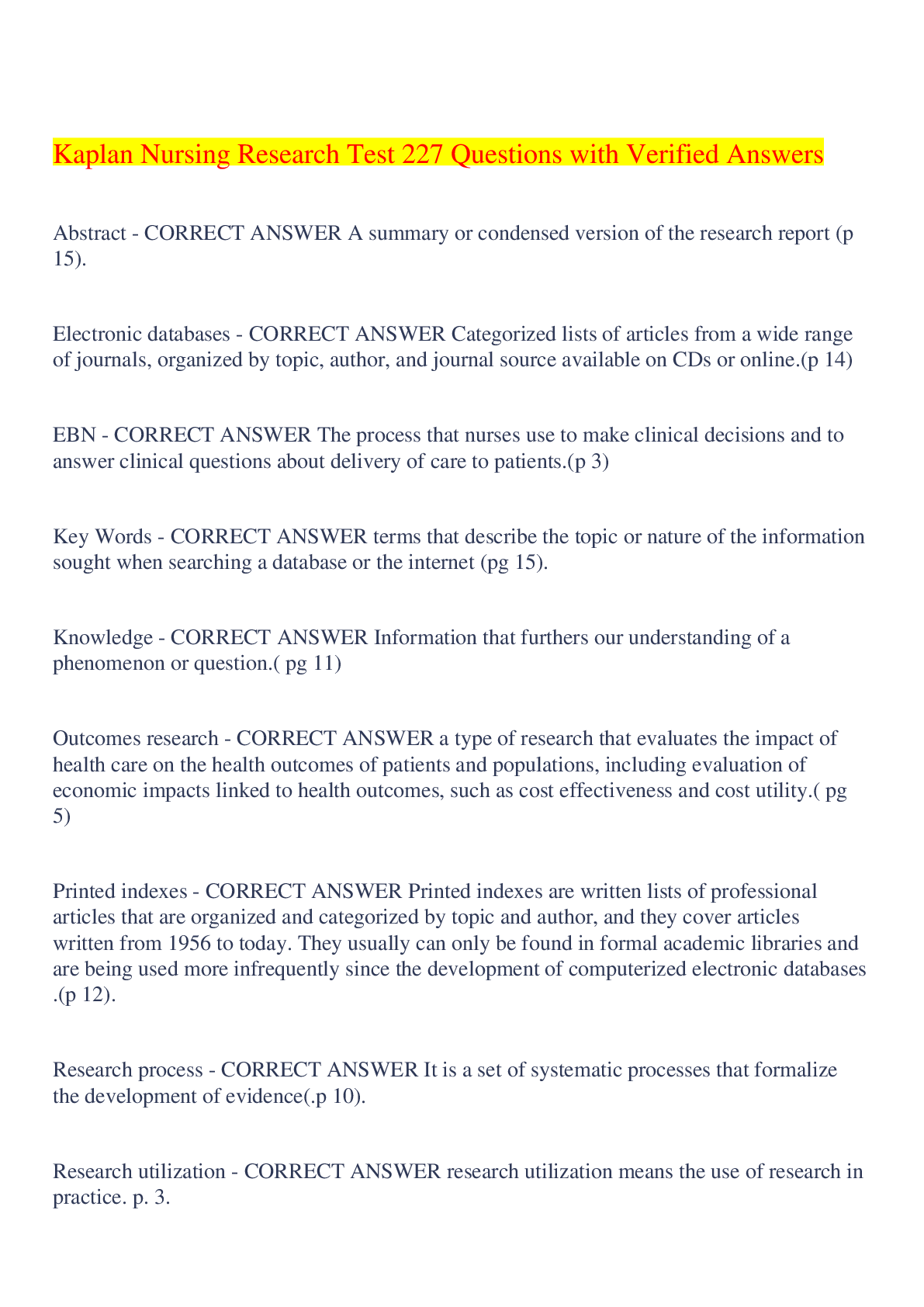
Buy this document to get the full access instantly
Instant Download Access after purchase
Buy NowInstant download
We Accept:

Reviews( 0 )
$9.50
Can't find what you want? Try our AI powered Search
Document information
Connected school, study & course
About the document
Uploaded On
Dec 26, 2023
Number of pages
26
Written in
Additional information
This document has been written for:
Uploaded
Dec 26, 2023
Downloads
0
Views
45


